Some antique Donegals have sold for huge sums of money; this reproduction, in the Donnemara pattern from C.F.A. Voysey, is available from Nature’s Loom.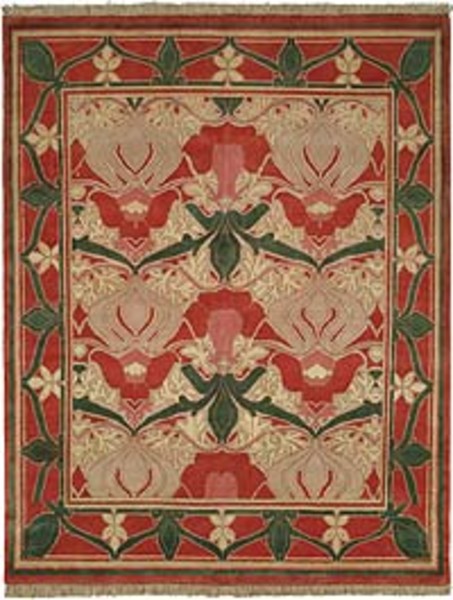
Rugs were an important part of Arts & Crafts houses. Far more than mere floor coverings, their colors, textures, and patterns helped integrate house and furnishings in the pursuit of a totally designed environment. Many folks who own or restore these houses today appreciate the creativity in their brick or stone fireplaces, or the beauty of their wood moldings and floors, and look to add the finishing touch with an area rug. For lovers of bungalows, Prairie-school houses, and other buildings from the early 20th-century, the search often revolves around rugs with an Arts & Crafts aesthetic.
As the current revival of the Arts & Crafts movement continues to grow, it has sparked a veritable rug renaissance that has been unfolding for almost a decade. Every year, companies increase the number of handsome reproductions on the market, and one can now find rugs of all types in all price ranges and from all over the world. Like reproductions of oak furniture and copper lighting, today there are more options for Arts & Crafts rugs than ever before-and with them comes a wealth of ways to complete an Arts & Crafts home.
Rugs at 1900
What is an Arts & Crafts rug? It’s a good question to ask if you’re looking to buy, yet tricky to answer given that the Arts & Crafts movement was not a style but a group of ideas, a point of view. Since the movement rejected superfluous ornamentation, and had a visual vocabulary inspired by nature, rugs typically featured simple, bold, informal design themes rooted in the great outdoors. Some favorite earthy (and highly stylized) motifs were gingko leaves, thistles, flowers and, in the case of William Morris designs, willow trees.
A reproduction Gustav Stickley drugget rug—in a flat weave, with an overlapping geometric pattern—is on display in the living room of Craftsman Farms, his New Jersey home. Paul Stubblebine photo courtesy of The Craftsman Farms Foundation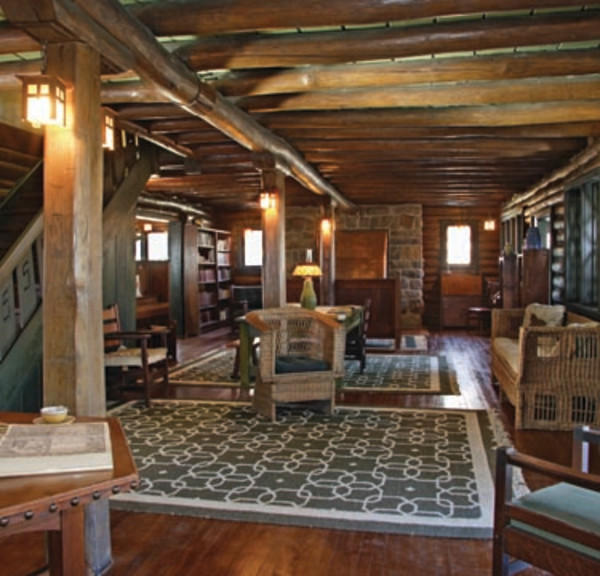
What Arts & Crafts rugs looked like at the turn of the century certainly varied. Colorways ran the spectrum from hallmark moss greens and shades of gold to more vibrant, gemstone-inspired palettes. Rug patterns also took many forms; from a single stylized element intertwined throughout, to a simple color block center with repeating border, to combinations of the two. Construction ran the gamut too, from hand- or machine-made tufted rugs imported from Europe, to flat-woven rugs, such as those made by Native Americans, to hand-hooked rugs made in America. A famous example of the latter were the Abnakee rugs created by Helen Albee, sparse designs sold at the Arts & Crafts Exhibition sponsored by Gustav Stickley in 1903. Stickley himself sold a few rugs-mostly coarse, flat-woven Indian druggets with plain, overlapping geometric patterns that exemplified his thinking on floor coverings. In his 1910 catalog, he noted that rugs should be unobtrusive in design, and give, a quiet and harmonious background to the furnishings.
While a variety of designs were woven on power looms by a host of American manufacturers, those with the pocketbook could buy-or commission-hand-knotted Persian-style rugs based on the designs of William Morris manufactured in England, or others by architect C.F.A.Voysey made in Scotland by a firm called Donegal Carpets. Donegal is the only producer of Arts & Crafts rugs in the 19th century that continues to make them today. It was founded in 1898 by Scottish textile magnate Alexander Morton, who established a hand-woven rug plant on the west coast of Ireland, drawing on the talents of locals who had worked with wool and weaving for generations.
Historic in origin, the Oak Park pattern from Persian Carpet blends three botanical themes from the Arts & Crafts movement—poppies, oak leaves, and grapes.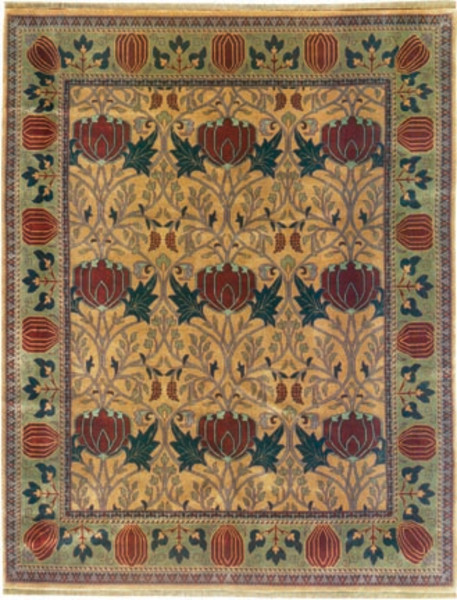
Original Issues
Most original Arts & Crafts rugs were quite coarsely woven by today’s standards, featuring a count of between 25 and 45 knots per square inch in tufted rugs. Knots form the pile, so a higher count means a thicker, plusher rug; for comparison, a fine rug with intricate designs has 200 to 300 knots per square inch. These coarse weaves were in keeping with the simple and informal Arts & Crafts designs—a backlash against the fussy patterns popular during the Victorian era-and manufacturers were able to use thicker wool to achieve these designs. (The lifespan of the rug, however, is sometimes shorter than rugs with a higher knot count.) Unrefined as they might appear, Arts & Crafts rugs were sold at upscale venues like Liberty of London and Stickley’s Craftsman showrooms in Boston and New York. Donegals were actually intended to be a lower-budget substitute for Morris carpets, says Tracy Davis, Donegal’s Director of Operations. Because Morris’s rugs were made in England, they were more expensive to produce. The rugs also differed a bit in their construction. Morris carpets used cotton for the warp, which forms the fringes, and some sort of bast (woody) fiber like jute, linen, or hemp for the weft-the filling thread that secures the knots in the pile. Donegals were usually constructed using only wool for the warp, weft, and pile. From a technical standpoint, Davis says using cotton or bast fiber for the foundation can result in better dimensional stability, since those fibers don’t stretch much when wet, like wool can. But wool has the upside of being impervious to rot and other fungal problems that attack bast. In terms of longevity, It’s really probably about a wash, notes Davis.
The dying processes differed as well. Scholars believe Morris only used natural dyes in his carpets, consistent with his overall philosophy. He was a purist, explains Davis. Donegal, on the other hand, used synthetic dyes that were less labor-intensive. A century ago, there were downsides to both methods. Morris’s lack of dying expertise resulted in pieces that are somewhat washed-out looking, says Davis, while the original Donegals were garish in color. Nowadays, of course, dying technology has been perfected for decades, and you can find quality, long-lasting rugs made from a number of materials-wool, silk, and mohair among them-in both natural and synthetic dyes (also called chrome dyes).
An interpretive design from L. & J.G. Stickley called Light Tulip Fest is one of their most popular rugs.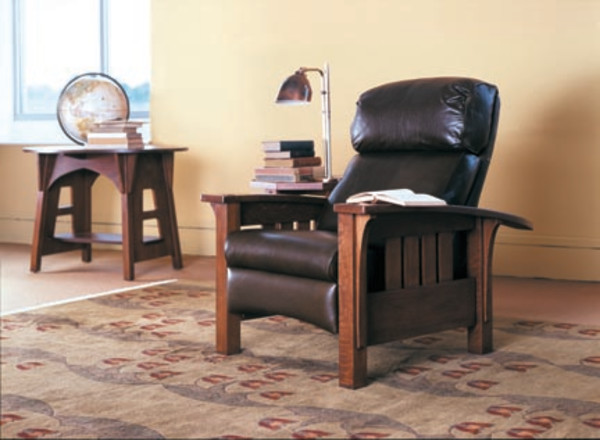
Choices, Choices
Today, the rug industry sees Arts & Crafts as a new niche market, and suppliers are making every effort to offer products true to the roots of the movement’s ideals-an emphasis on craftsmanship, quality, and informality. The biggest price differentials stem from the type of manufacturing process and the kinds of materials used in weaving the rug. For example, a rug that’s machine-loomed out of wool will be much less expensive than one of the same design hand-knotted out of mohair. Nowadays Arts & Crafts rug production is also a global industry, ranging from England and Scotland to Tibet, Nepal, India, and China. Modern rug manufacturers seek inspiration from the leading designers of the Arts & Crafts period—Morris, Stickley, Voysey, Charles Rennie Mackintosh, and Dard Hunter. Current rugs can be found in a number of original patterns, as well as some looser interpretations of designs from the era. In a way, the most important choice an old-house owner has to make is the nature of design he or she hopes to find—original, historical, or interpretive—because almost all exist in a variety of materials and prices. There are so many creative Arts & Crafts rugs on the market today, it’s hard to categorize their design provenance beyond some general groupings.
An authentic design is a copy of an original rug—for example, one designed by Voysey that was first in production over a hundred years ago. Donegal Carpets still offers such rugs—hand-knotted on the historic looms of its Killybegs factory, which were reopened in 1999. These Irish originals, however, come at a price (about $250 per square foot). As an alternative, Donegal also offers a line of eight authentic carpets that are produced in India in pure wool. These designs—most of which haven’t been seen for nearly a hundred years—are re-created from their archives and are more reasonably priced at approximately $55 a square foot.
A hand-hooked JAX rug made of wool in a wreath pattern fits nicely with the Arts & Crafts décor of this home.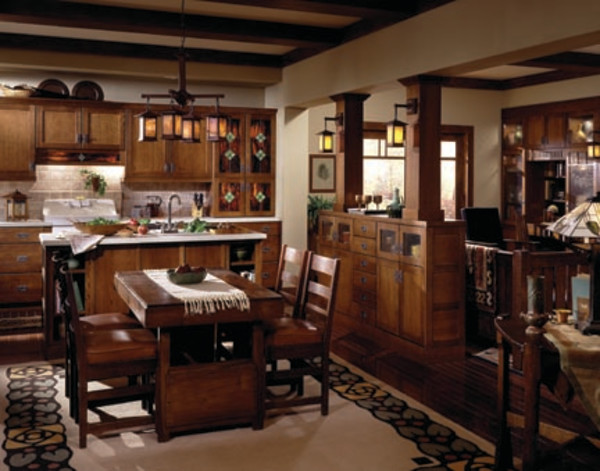
The J.R. Burrows & Company of Rockland, Massachusetts, is another example of an authentic design source. They feature exact reproductions of rugs by Morris that are woven to order in England on Wilton or Brussels looms of 80 percent wool and 20 percent nylon. One of these, the Tulip & Lily pattern, designed by Morris in 1875, is considered among the best known Arts & Crafts Movement carpets, and is one of the only 19th century designs to be kept in current production throughout the 20th century. A third approach is JAX Arts & Crafts of Berea, Kentucky, which works hard to create rugs as true as possible to the originals down to the knot count and yarns used. JAX began in the early 1990s when owner Del Martin and his wife Jerri were dissatisfied with Turkish copies of Donegal rugs they bought for their own home. “I’m obsessive about getting reproductions exactly right,” says Del. Their company now offers a wide range of authentic designs, from William Morris to Gustav Stickley, made in Nepal and China, with their hooked rugs going for about $12.50 per square foot.
Rugs with historically based designs take original Arts & Crafts motifs or patterns that were initially created for a different medium: applying a Dard Hunter border, for example, or a Morris curtain, to a rug instead of paper or fabric. These are authentic designs of the movement, but they’re being used in a totally new way. Some rugs even combine the work of two different people, like Voysey and Morris. The sources for these designs are abundant, and there are countless versions of them.
Called Liberty Balloons, the Frank Lloyd Wright design on this interpretive rug from Peerless was pulled from a drawing the architect made for the cover of Liberty Magazine in 1927.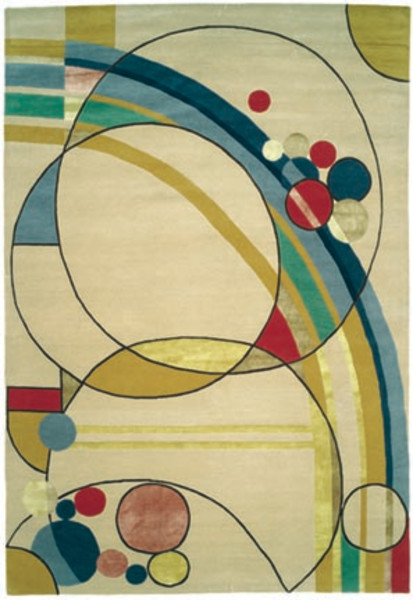
Stickley Furniture of Manlius, New York, first started offering rugs in 1999 and has many historically based designs. All the rugs in their Arts & Crafts series are hand-knotted in wool and of heirloom quality; most are made in Nepal. Their Falling Leaves and Light Tulip Fest patterns have been quite popular; both feature botanical designs and retail for about $67 a square foot for standard sizes. The Persian Carpet of Durham, North Carolina, has a host of historic designs as well that are hand-knotted in India from imported New Zealand wool. Another group of rugs, sometimes described as ‘interpretive’ or ‘inspired,’ take design ideas from artifacts within the Arts & Crafts movement—a carving from a Mackintosh desk, for example, or one component of a complex Frank Lloyd Wright stained glass window—and turn it into the building block for a rug. These rugs are some of the most popular today because they have been specifically created with modern-day tastes in mind. For instance, Tiger Rug of Warwick, Rhode Island, offers designs that emulate motifs from the Craftsman catalog of Gustav Stickley in a line made in Nepal. The Meadow collection from Nature’s Loom features about a dozen Arts & Crafts inspired designs, all hand-knotted in wool and made in India. Peerless rugs of Chicago has a large group of rugs based on Frank Lloyd Wright’s windows and architecture, many of which are made-to-order, also in Nepal.
The bottom line is, there’s a rich array of quality, interesting, and beautiful floor coverings available to complement today’s Arts & Crafts homes. Like buying antiques or artwork, choosing which rugs best fit into your decor is a matter of color scheme, pocketbook, and personal taste—the same criteria for making Arts & Crafts rug purchases at the beginning of the last century, too.
Watch the Video
https://www.youtube.com/watch?v=CGB0qEox56M" frameborder="0" allowfullscreen=""><







